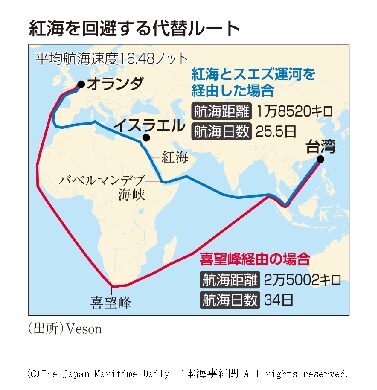
“Red Sea Route Grows in Importance: 17,000 Vessels Per Annum, Affecting Carriers and Tankers Worldwide
In an effort to evade potential attacks by Yemen’s Houthi militant group, a growing number of car carriers and tankers, in addition to container ships, are now rerouting via the Red Sea. Official statistics indicate that approximately 17,000 vessels, constituting 10% of global trade, annually navigate through the Red Sea enroute to the Suez Canal. This shift has triggered a surge in share prices of prominent global shipping firms, driven by speculation of a tightening supply-demand balance in shipping capacity.
December 19, 2023, marked a significant date when numerous global shipping corporations announced alternative routes bypassing the Red Sea, resulting in a dramatic rise in their stock values.
As of 3:00 p.m. on December 21st, shares of Nippon Yusen Kabushiki Kaisha (NYK) were valued at ¥4,426, Mitsui O.S.K. Lines (MOL) at ¥4,604, and Kawasaki Kisen Kaisha, Ltd. at ¥6,348. Each of these companies witnessed their share prices escalating by 80 to over 200 yen from the previous day.
Major global shipping stocks also continued their upward trajectory, with AP Moller-Maersk increasing by 3% from the previous day, Hapag-Lloyd by 1.5%, and Yang Ming Shipping by 9.9%, in their respective markets.
A shipping broker commented, ‘Shipping is inherently political, thus market escalations are inevitable with the intensification of conflicts, civil unrest, and accidents.’
Historically, events like the Iraq War in 2003 and Hurricane Katrina in 2005 in the U.S. have caused sharp increases in freight rates for crude oil and product tankers. Similarly, the grounding of the 20,000 TEU container ship EVER GIVEN in 2021 in the Suez Canal also led to a tightening of container shipping capacity.
The duration of the latest Houthi attacks on shipping remains uncertain.
Shipping experts note that the journey from Taiwan to Europe via the Red Sea route takes about 25.5 days at a speed of 16.48 knots, compared to 34 days via the Cape of Good Hope detour. This equates to an approximate increase of 10 days. However, ‘the sea conditions off the Cape of Good Hope are often turbulent and challenging,’ adds a shipping official.
Simple calculations of the additional days required for the detour do not fully capture the complexities involved.
On April 19, Wallenius Wilhelmsen, a major European car carrier and RORO operator, announced its decision to reroute all vessels originally scheduled to transit the Red Sea via the Cape of Good Hope. Several leading Japanese shipping lines have also begun diverting their car carriers from the Red Sea route.
According to Clarkson’s Research, the current global fleet of car carriers stands at 760, with 170 vessels on order, representing about 30% of the existing capacity. However, most of these vessels are not scheduled for completion until 2025 or later, leading to a continued scarcity in car carrier capacity, as per a shipping executive.
The rerouting away from the Red Sea affects not only container ships and car carriers but also a variety of vessels including LNG (liquefied natural gas) carriers, Suez-type tankers, and bulk carriers.
For LNG carriers, particularly, the Red Sea is a critical route for transporting gas from Qatar to Europe.
‘The LNG carriers will be owned by shipping giants, with Qatar as the charterer. Given Qatar’s geopolitical stance, we must cautiously opt for routes avoiding the Red Sea,’ stated a senior shipping executive.
Shippers who have prepaid freight are unlikely to bear additional costs for the detour. However, for future Asia-to-Europe cargoes, ‘shipping lines planning to bypass the Red Sea might impose additional freight charges on shippers, regardless of vessel type,’ according to a trade company’s shipping department.
Meanwhile, bunker (fuel oil) loading operations have commenced in South Africa, which is emerging as a pivotal base for the diversion.
A local bunker publication reports that South African bunker suppliers anticipate a 2% increase in overall bunker consumption by container ships compared to last year, owing to the Suez Canal diversion.
Typically, the January-March period, coinciding with Brazil’s rainy season and the Chinese New Year in February, witnesses a slowdown in shipping, leading to a market decline.
Should the Suez Canal blockage persist, a significant uptick in the shipping market is highly probable. Shipping companies are now vigilantly monitoring the future impact on the Red Sea shipping market and the safety of their fleets. – a staff writer, Hirofumi Yamamoto”